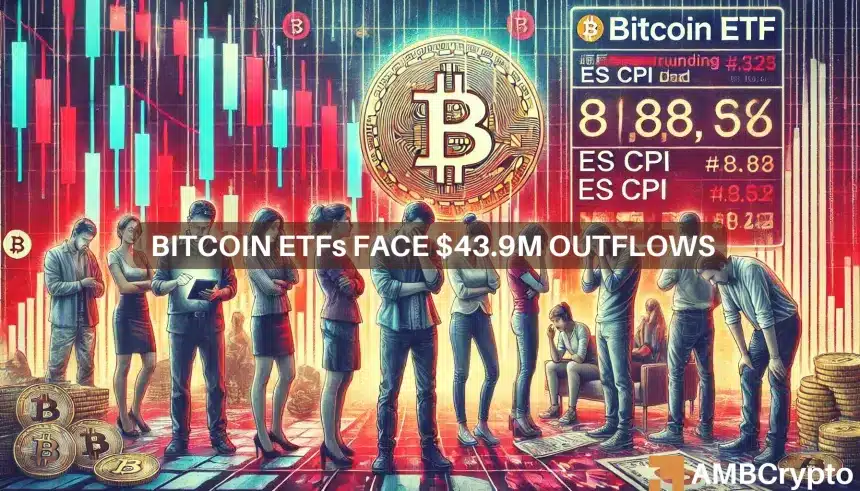Bitcoin
Will Bitcoin ETF flows turn negative again? What’s causing market jitters
Could recent ETF outflows and cryptocurrency price shifts be linked to the latest U.S. CPI data?

- Bitcoin and Ethereum ETFs saw short-lived inflows, followed by significant outflows.
- U.S. CPI data influenced ETF flows, with cryptocurrencies rebounding despite initial declines.
After days of persistent outflows, Bitcoin [BTC] ETFs saw a brief resurgence with inflows on the 9th and 10th of September.
This uptick, however, was short-lived.
Bitcoin ETF suffers outflow
On the 11th of September, the trend reversed sharply with net outflows totaling $43.9 million, according to Farside Investors.
This abrupt shift ended a two-day streak of positive inflows, highlighting the volatile nature of BTC ETF investments in the current market environment.
Surprisingly, BlackRock’s IBIT has been stagnant with zero flows since the 26th of August, except for a notable outflow of $9.1 million recorded on the 9th of September.
Meanwhile, only Fidelity’s FBTC and Invesco’s BTCO have shown positive movement, with inflows of $12.6 million and $2.6 million, respectively, as of the 11th of September.
In contrast, Ark Invest and 21Shares’ ARKB experienced significant outflows, totaling $54.0 million, according to Farside Investors.
Additionally, Grayscale’s GBTC reported net outflows of $4.6 million, underscoring the continued volatility and shifting dynamics in the Bitcoin ETF market.
Ethereum ETF analysis
Similarly, Ethereum [ETH] ETFs mirrored the recent fluctuations seen in BTC ETFs.
After a period of outflows, ETH ETFs experienced a brief surge with $11.4 million in inflows on 10th September as per Farside Investors.
However, this positive trend was short-lived, as the following day saw a cumulative outflow of $0.5 million.
Notably, while most Ethereum ETFs recorded no flow, Fidelity’s FETH achieved a modest inflow of $1.2 million, whereas VanEck’s ETHV faced outflows totaling $1.7 million.
This divergence highlights an unusual pattern where BlackRock’s ETFs have been consistently stagnant, in stark contrast to Fidelity’s ETFs, which have shown resilience.
On the price front, both Bitcoin and Ethereum saw declines on 11th September.
Yet, by the 12th of September, both cryptocurrencies rebounded, with BTC gaining 3.3% and ETH rising by 1.58% within a day, as per CoinMarketCap.
What’s causing this?
The sudden shift in ETF flows and cryptocurrency prices may be attributed to the recently released U.S. Consumer Price Index (CPI) data.
The CPI for August revealed a modest 0.2% increase in consumer prices, bringing the 12-month inflation rate down to 2.5%—the lowest level since February 2021, as reported by CNBC.
This data has prompted Citi to project a more conservative 25 basis point rate cut at the upcoming Federal Open Market Committee (FOMC) meeting.
Despite this anticipated adjustment, Citi’s analysis highlights that core PCE inflation, a critical factor for Fed policy, remains steady, suggesting a balanced approach to monetary policy in the near term.
As expected, Rachael Lucas, a crypto analyst of BTCMarkets put it best when said,
“Outflows from Bitcoin and Ethereum ETFs are largely a reaction to stronger U.S. economic data and should be seen as a normal part of ETF evolution.”

